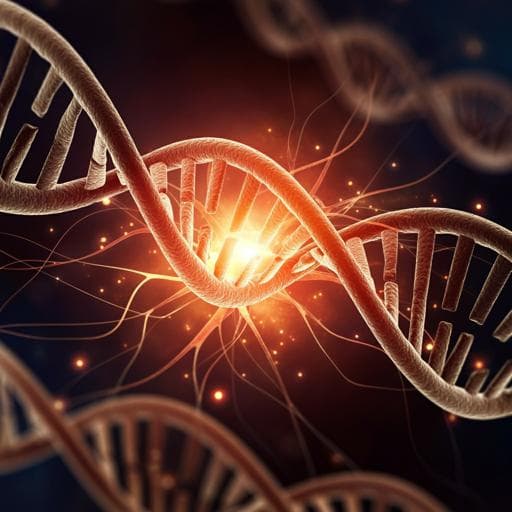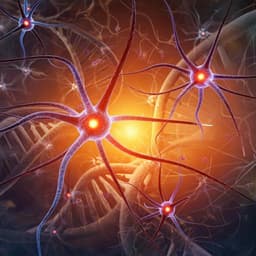
Medicine and Health
HDAC1 modulates OGG1-initiated oxidative DNA damage repair in the aging brain and Alzheimer's disease
P. Pao, D. Patnaik, et al.
Exciting research by Ping-Chieh Pao and colleagues reveals how HDAC1 influences the brain's ability to repair DNA damage, which is crucial for combating aging and neurodegenerative diseases. Their findings show that enhancing HDAC1 activity could be a promising therapeutic approach to mitigate cognitive decline.
~3 min • Beginner • English
Introduction
Aging is associated with progressive physiological decline and increased vulnerability to disease. Genomic instability due to accumulated DNA damage is a hallmark of aging and is linked to mutations, altered gene expression, and cognitive impairment in the human brain. Impairments in DNA repair pathways contribute to neurodegenerative conditions, including Alzheimer’s disease (AD), where post-mortem brains show increased double-strand breaks (DSBs) and reduced DSB repair capacity. Mouse models exhibit elevated DNA damage prior to overt neurodegeneration, and exacerbating base excision repair deficits worsens AD pathologies, suggesting that enhancing DNA repair could mitigate decline. Histone deacetylases (HDACs) regulate transcription, chromatin, and DNA repair. HDAC1, a class I HDAC, promotes DSB repair via non-homologous end joining by deacetylating H3K56 and H4K16. It remained unclear whether HDAC1 also regulates other DNA repair pathways and whether HDAC1 is required for proper gene expression and brain function during aging. This study investigates the role of HDAC1 in oxidative DNA damage repair, specifically 8-oxoG base excision repair via OGG1, and evaluates its impact on aging-related gene expression, synaptic plasticity, cognition, and AD-related pathology.
Literature Review
Prior work links genomic instability to aging and cognitive decline in humans, and mutations in DNA repair genes to premature aging and neurological phenotypes in rodents and humans. AD brains show elevated DSBs, reduced expression of DSB repair factors, and reduced non-homologous end joining. Mouse models (CK-p25, Tau P301S) show increased DNA damage before symptoms. Reducing DNA repair capacity (e.g., Pol β haploinsufficiency) worsens AD phenotypes, while enhancing repair correlates with improved outcomes and increased lifespan in certain species. HDACs are key chromatin regulators; HDAC1 supports neuronal genomic stability and DSB repair, but its role in other repair pathways was unclear. Oxidative lesions such as 8-oxoG accumulate with age and in AD, can interfere with transcription factor binding at guanine-rich motifs (e.g., SP/KLF), and are predominantly repaired by base excision repair glycosylases, especially OGG1. OGG1 is known to be acetylated by p300, modulating its activity, suggesting post-translational regulation of oxidative repair enzymes may be critical in brain aging and neurodegeneration.
Methodology
- Mouse models: Generated brain-specific Hdac1 conditional knockout (cKO) mice by crossing Hdac1fl/fl with Nestin-Cre (neurons and astrocytes). Crossed Hdac1 cKO with 5XFAD transgenic AD model to generate compound mice. Used aged C57BL/6J mice for pharmacology experiments.
- Genotyping/validation: Western blot and immunohistochemistry to confirm HDAC1 loss in neurons and astrocytes; microglia retained HDAC1.
- Histology and cell counts: Immunostaining for GFAP, NeuN, IBA1, cleaved caspase-3; 3D image analysis (Imaris) to quantify astrocyte number, GFAP intensity, and astrocyte volume.
- DNA damage assays: Alkaline comet assay on hippocampal homogenates to quantify general DNA damage by tail moment. FPG-modified comet assay to specifically detect oxidative lesions (8-oxoG) by converting them to strand breaks with FPG. Co-staining for 8-oxoG with neuronal (NeuN) and astrocytic (GFAP) markers to assess cell-type specific oxidative lesions.
- Behavior: Contextual fear conditioning for hippocampal-dependent memory; Morris water maze (MWM) for spatial learning and memory, including probe trials and control measures (swim velocity, visible platform).
- Electrophysiology: Field recordings in acute hippocampal slices (CA1) to assess long-term potentiation (LTP) induced by theta-burst stimulation.
- Transcriptomics and chromatin profiling: RNA-seq on hippocampal tissue from young and aged Hdac1 cKO and control mice; RNA-seq on 5XFAD and compound mice. HDAC1 ChIP-seq in young WT hippocampus to determine genomic binding sites. Motif enrichment (HOMER) and GO analysis (GSEA/MSigDB). 8-oxoG ChIP-qPCR at selected promoters of DEGs.
- OGG1 biochemistry: In vitro acetylation of recombinant OGG1 with p300 and deacetylation with recombinant HDAC1. Western blot for acetyl-lysine to quantify OGG1 acetylation. OGG1 cleavage assay using an IRDye-labeled oligonucleotide substrate containing a single 8-oxoG to quantify base excision and AP incision product (17-nt). Mass spectrometry to map acetylation sites modulated by p300 and HDAC1.
- Protein interactions and activity: Co-immunoprecipitation from cortical/hippocampal nuclear extracts to detect HDAC1-OGG1 interaction. Measured endogenous OGG1 acetylation and OGG1 activity in hippocampal nuclear extracts from control vs Hdac1 cKO. Assayed HDAC1 and p300 enzymatic activities from hippocampal lysates.
- Pharmacology: Identified exifone as an HDAC1 activator. Administered exifone intraperitoneally (50 mg/kg) to aged WT mice (4 weeks) and to 5XFAD and non-Tg mice (2 weeks). Also delivered exifone intracerebroventricularly (100 ng/day, 2 weeks). Assessed brain exposure by LC/MS/MS. Evaluated effects on comet assays (alkaline and FPG), OGG1 activity, behavior (fear conditioning, MWM probe), and LTP. In vitro, tested exifone effects on histone acetylation (H4K12ac) and γH2AX in neurons, and assessed specificity via Hdac1 knockdown.
- Oxidative stress model in vitro: Exposed primary cortical neurons to mild H2O2 to induce 8-oxoG without affecting viability. Assessed expression of aging-related, guanine-rich promoter genes. Tested whether exifone pretreatment rescues gene repression and whether Ogg1 knockdown abrogates rescue.
- Neuron-specific HDAC1 knockdown in vivo: Stereotaxic AAV-PHP.eB delivery of shHdac1 or scrambled control with mCherry into hippocampus of aged WT mice; confirmed knockdown by immunostaining; assessed spatial memory by MWM.
- Statistics: Student’s t test, one-way/two-way ANOVA with appropriate post hoc tests, Fisher’s exact test; results reported as mean ± SEM. RNA-seq thresholds: fold change ≥1.5, P<0.05. Data availability in GEO (GSE115437, GSE147407).
Key Findings
- HDAC1 loss and aging phenotypes: Hdac1 cKO mice show age-dependent astrogliosis with increased astrocyte number and GFAP intensity at 13 months, enlarged astrocyte volume, and increased DNA damage (higher comet tail moment) specifically in aged animals.
- Cognitive and synaptic deficits: Aged Hdac1 cKO mice exhibited a 22.2% reduction in contextual fear freezing vs controls; in MWM, increased escape latencies and a 50.3% reduction in time spent in the target quadrant during probe trial. LTP was impaired at 6 months in Hdac1 cKO (not at 2 months).
- Transcriptomic alterations with age: Young Hdac1 cKO had 115 DEGs (52 up, 63 down). Aged Hdac1 cKO had 479 DEGs, with 82.8% (397) downregulated, enriched for ion transport, response to stimuli, proteolysis regulation, aging, PKC pathway, chaperones, and antioxidant responses. HDAC1 ChIP-seq identified 7014 promoter/5′UTR binding sites; most downregulated DEGs lacked direct HDAC1 promoter binding, suggesting indirect mechanisms.
- Promoter motif and oxidative lesions: Downregulated genes in aged Hdac1 cKO were enriched for SP/KLF guanine-rich motifs. 8-oxoG ChIP-qPCR showed elevated 8-oxoG at promoters of four downregulated genes (Prkcd, Gpx3, Slc4a5, Slc18a2), but not at three upregulated genes. FPG comet assays indicated increased 8-oxoG lesions in aged Hdac1 cKO, with elevated 8-oxoG signal in both neurons and astrocytes.
- HDAC1 regulates OGG1: In vitro, HDAC1 deacetylated p300-acetylated OGG1 and enhanced OGG1 cleavage activity beyond p300 stimulation; effects required prior acetylation and were lost with HDAC1 inactivation/inhibition. In vivo, HDAC1 co-immunoprecipitated with OGG1; aged Hdac1 cKO hippocampus showed increased acetyl-OGG1 and reduced OGG1 activity without change in OGG1 protein levels.
- AD model overlap and HDAC1 dysfunction: 5XFAD mice showed increased neuronal and astrocytic 8-oxoG; Hdac1 cKO;5XFAD compound mice had even higher neuronal 8-oxoG. RNA-seq in 5XFAD and compound mice revealed 581 and 703 DEGs vs controls, respectively, with downregulated genes enriched for SP-family guanine-rich motifs and significant overlap with aged Hdac1 cKO downregulated genes (150 shared downregulated genes across all three groups; functions mainly in ion transport). Hippocampal HDAC1 activity was reduced in aged 5XFAD (P=0.0135); p300 activity was unchanged.
- Pharmacological activation of HDAC1: Exifone reduced H4K12ac in neurons (blocked by Hdac1 knockdown), reduced γH2AX in CK-p25 neurons in vivo, and was brain-penetrant. In aged WT mice, exifone decreased 8-oxoG lesions (FPG comet) and increased hippocampal OGG1 activity without affecting non-oxidative damage (alkaline comet). In 5XFAD mice, exifone reduced FPG tail moment, improved contextual fear freezing, and enhanced LTP; similar benefits occurred with intracerebroventricular delivery.
- Oxidative stress gene repression: Mild H2O2 in neurons repressed genes downregulated in aged Hdac1 cKO; Hdac1 knockdown mimicked this repression. Exifone pretreatment alleviated repression, and Ogg1 knockdown attenuated exifone’s rescue, indicating OGG1 dependence.
- Neuron-specific HDAC1 knockdown: AAV-shHdac1 in aged WT hippocampus reduced HDAC1 in neurons and impaired spatial memory in the MWM probe (fewer platform crossings) without affecting learning phase, velocity, or vision.
Discussion
The study demonstrates that HDAC1 is a critical modulator of oxidative DNA damage repair in the aging brain by stimulating OGG1-dependent removal of 8-oxoG lesions. HDAC1 deficiency leads to accumulation of 8-oxoG at guanine-rich promoter motifs, particularly SP/KLF sites, causing transcriptional repression of genes essential for neuronal function, such as ion transporters and PKC pathway components. These molecular changes correlate with increased DNA damage, synaptic plasticity impairments, and cognitive decline. In the 5XFAD AD model, reduced HDAC1 activity and elevated 8-oxoG parallel a highly overlapping downregulated gene set, suggesting that HDAC1 dysfunction contributes to AD-related transcriptional dysregulation and oxidative DNA damage burden. Pharmacological activation of HDAC1 with exifone boosts OGG1 activity, selectively lowers 8-oxoG lesions, and improves memory and LTP in 5XFAD mice, supporting a causal link between HDAC1-mediated repair and functional outcomes. The findings position HDAC1 as a nodal regulator connecting chromatin-modifying enzymes, base excision repair, and transcriptional homeostasis in aging and neurodegeneration.
Conclusion
HDAC1 promotes OGG1-initiated base excision repair of 8-oxoG in the brain, protecting against age- and AD-associated oxidative DNA damage, transcriptional repression of neuronal function genes, synaptic deficits, and cognitive decline. Loss or inhibition of HDAC1 leads to increased 8-oxoG at guanine-rich promoters and reduced OGG1 activity, whereas pharmacological activation of HDAC1 (exifone) enhances OGG1 function, reduces oxidative lesions, and improves cognitive performance and LTP in aged and AD-model mice. These results highlight HDAC1 activation as a promising therapeutic strategy for mitigating brain aging and neurodegeneration. Future work should define the precise post-translational regulation of OGG1 by HDAC1 and p300, delineate mechanisms leading to HDAC1 dysfunction in AD (e.g., p25/CDK5 axis), assess long-term efficacy and safety of HDAC1 activators, and determine cell type-specific contributions (neurons vs astrocytes) to cognitive outcomes.
Limitations
- Exifone’s beneficial effects, while consistent with HDAC1 activation, may involve indirect or off-target actions; definitive target engagement and specificity in vivo require further validation.
- The mechanism underlying reduced HDAC1 activity in 5XFAD mice is hypothesized to involve p25/CDK5 but remains to be directly confirmed.
- Technical challenges limited assessment of LTP in very old mice; age-related synaptic plasticity effects beyond 6–14 months need deeper evaluation.
- Most transcriptional effects in Hdac1 cKO appeared indirect (limited promoter binding overlap), and causality between promoter 8-oxoG accumulation and gene repression was shown at selected loci; broader causal mapping is needed.
- Statistical assumptions of normality were not formally tested; sample sizes were aligned with prior studies but may limit detection of small effects.
Related Publications
Explore these studies to deepen your understanding of the subject.







